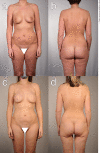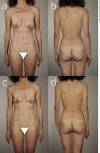Long-Term Outcome Analysis and Technical Refinements after Autologous Breast Reconstruction with PAP Flap: What We Have Learnt
- PMID: 36684404
- PMCID: PMC9851068
- DOI: 10.1159/000524309
Long-Term Outcome Analysis and Technical Refinements after Autologous Breast Reconstruction with PAP Flap: What We Have Learnt
Abstract
Introduction: The profunda artery perforator (PAP) flap represents a valuable alternative to the deep inferior epigastric artery perforator flap which, nowadays, is considered the golden standard for autologous breast reconstruction. The goal of this study was to evaluate the long-term satisfaction, functional outcomes of the donor site following PAP flap-based breast reconstruction and to present our personal learning experience along with suggestions for technique refinements.
Methods: In this prospective single-center appraisal, 18 patients who underwent PAP flap-based breast reconstruction between January 2016 and November 2019 were enrolled. The Patient and Observer Scar Assessment Scale (POSAS) and the Breast-Q questionnaire were employed to evaluate the results 12 months postoperative. Data were analyzed with the Q-Score program. Complications were recorded in the medical database and classified with the Clavien-Dindo classification.
Results: In the questionable time frame, 164 female patients underwent free flap breast reconstruction. Of those, 18 patients that received PAP flaps (9 bilateral) were included in this study. We recorded one flap loss because of venous failure. Most complications concerned the donor site, including hematoma, seroma, and wound healing problems. Patients' satisfaction was high at 12 months post-surgery, despite critical evaluation of the donor site scar.
Conclusion: The PAP flap serves as an excellent option for breast reconstruction in patients who do not have abundant abdominal tissue. The overall clinical outcome was good and patients' evaluation showed high satisfaction after 12 months despite high complication rates. Modifications in planning and flap harvesting might improve the donor site outcome and the overall complication rate.
Keywords: Breast; Breast cancer; Breast reconstruction; Breast-Q; Flap surgery; Free flap; Long-term outcome; PAP flap; POSAS; Profunda artery perforator flap; Vertical PAP flap.
Copyright © 2022 by S. Karger AG, Basel.
Conflict of interest statement
The authors have no conflict of interest to declare.
Figures



References
-
- Granzow JW, Levine JL, Chiu ES, Allen RJ. Breast reconstruction using perforator flaps. J Surg Oncol. 2006;94((6)):441–454. - PubMed
-
- Allen RJ, Haddock NT, Ahn CY, Sadeghi A. Breast reconstruction with the profunda artery perforator flap. Plast Reconstr Surg. 2012;129((1)):16e–23e. - PubMed
-
- Haddock NT, Greaney P, Otterburn D, Levine S, Allen RJ. Predicting perforator location on preoperative imaging for the profunda artery perforator flap. Microsurgery. 2012;32((7)):507–511. - PubMed
-
- Haddock NT, Cho MJ, Teotia SS. Comparative analysis of single versus stacked free flap breast reconstruction: a single-center experience. Plast Reconstr Surg. 2019;144((3)):369e–77e. - PubMed
LinkOut - more resources
Full Text Sources
Research Materials

